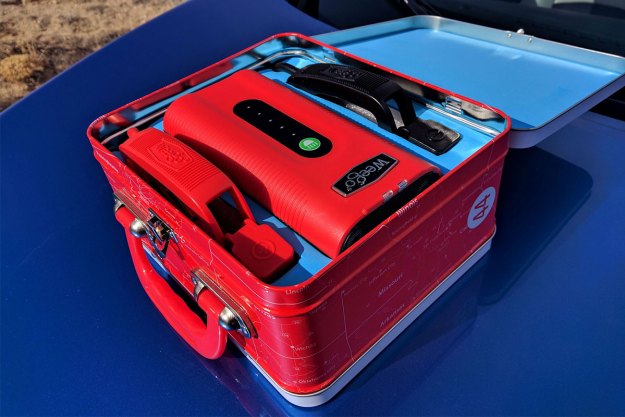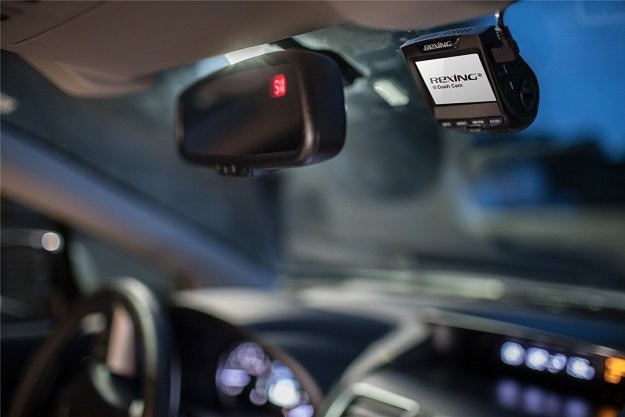
“The new Weego 44 has more power, better design, and is easier to use than the older model.”
- New visual LEDs indicate proper connection
- Durable and water-resistant construction
- Detect-o-Matic USB charging port detects max charging power
- Increased power to jump larger vehicles
- Exclusion of 19V laptop adaptor
A portable jump-starter is an accessory you pray you never use but really appreciate once you are stranded with a dead car battery. Weego continues to improve upon its last Heavy Duty Jump Starter with the latest Weego 44 model. Will this send the old jumper cables to the trash heap? We set out to test its limits and find out.
In the box
The packaging for this new Weego 44 really stands out thanks to its resemblance to an older tin lunch box. Once you have popped the box open, you will see a bright orange charge pack along with the two positive and negative clamps. The included water-resistant storage bag is also bright orange, making the components of this Weego 44 much easier to find while digging around in a dark trunk. The main charger pack is a solid 1.5pounds and measures 6.5 inches by 3.375 inches by 1.5 inches. It features a textured siding to help with grip that feels really solid and of much higher quality than most of the bargain jump-starters on the market.
The bottom has a power button, 15V/1A charging input, and metal post for mounting an included lanyard. The power button illuminates and gives good, clear indication that the unit is powered on or off to help avoid leaving the pack on to drain after use. Handily, the front of the pack shows the power level and features a button for the 500 Lumen LED flashlight. This flashlight will cycle with each press through steady light, strobe, SOS, and off modes. On a full charge, the unit is good for more than 14 hours of flashlight time. We left it on during a day of testing and over the course of 5 to 6 hours, we barely dented the power level.
Jump starting
The top side of the Weego 44 features a flip-top to cover the top ports. This helps the device earn a IP65 rating for water-resistance and protection against some dust and debris. In addition to the LED lights, the top cover hides the single Detect-o-Matic USB port that will detect your device and provide the maximum charging output of either 5V, 9V, or 12V at 2.4A. In testing, this worked nearly as fast as the included Quick Charger for our Nexus 6. Noticeably missing from this new package is the cable and adapter to charge laptops or your mobile devices. However, most users will have an existing USB charging cable for their phone and the laptop adaptor to plug into the 19V port is available for purchase on the Weego website.
The plastic handles give even the most novice user the confidence to not give themselves a jolt.
The included jumper cable features the newest “Smarty Clamps” design, which makes it easier to expand the clamps and attach them properly to your battery terminals. They work very well and the plastic handles give even the most novice user the confidence to not give themselves a jolt. The other basis for the “Smarty” name is a new readout to let you know when the cables are properly connected. This was a featured we loved in competing products like the Anker Jump Starter and it gives feedback to help the user jump their vehicle safely. The new Weego 44 system will even indicate when the vehicle engine is too large, if the system is connected to the wrong terminals, or even when the battery is cranked longer than recommended. We tested the system on a 2012 Lincoln MKZ Hybrid (2.5 liters) and a 2005 Honda Element (2.4L), and both started without any hesitation. This should come as no surprise since the Weego 44 is rated for gasoline engines up to 6.4L or diesel engines at 3.2L. Sadly, we did not have a Dodge Challenger SRT 392 around to test the top of its limits, but the Weego system should have no issues for the majority of vehicles on the road.
Our Take
With the latest update, the company has improved upon the original design in every way. The new Weego 44 has more power, better design, and is easier to use than the older model. All these upgrades only increased the price from $130 to $150, making the Weego 44 hard to beat in quality and value.
Is there a better alternative?
For this price range, there is simply no better alternative, and most cheaper options come from companies that don’t focus solely on a portable jumper pack technology like Weego.
How long will it last?
We don’t foresee car battery technology changing drastically in the future, and engine displacement will only get smaller and smaller. The system is rated at over 1,000 charge cycles and should outlive most vehicles.
Should you buy it?
A portable jumper pack is a must have for most vehicles owners, and if you are willing to pay a slight premium for a brand name in the portable jumper market, then the Weego 44 should be an easy choice.



